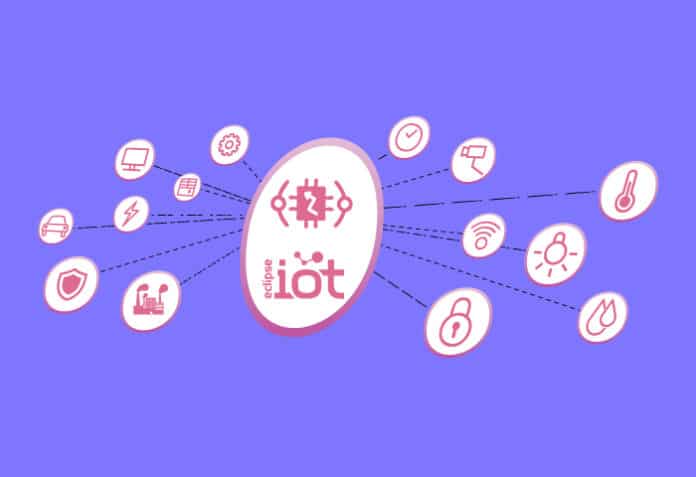Let’s delve into the essence of IoT, explore its profound impact across diverse industries, and introduce the pivotal role of open source software in shaping its evolution.
IoT, short for the Internet of Things, encompasses a vast network of interconnected physical entities objects, devices, vehicles, and so on. These entities are equipped with sensors, software, and network connectivity, allowing them to autonomously collect, exchange, and analyse data. This enables them to interact with and respond to their environment. The fusion of the physical and digital realms redefines the way we gather, process, and harness information, ushering in a new era of connectivity and intelligence.
IoT’s significance in industries and open source software’s impact
IoT’s significance transcends mere technological innovation, promising to revolutionise a multitude of industries such as healthcare, agriculture, manufacturing, and transportation. In healthcare, IoT devices offer real-time patient monitoring, elevating the quality of care and enabling remote patient oversight. Agriculture benefits from IoT-powered sensors optimising crop management and sustainable irrigation practices, while manufacturing gets efficient through predictive maintenance and downtime reduction. These examples underscore IoT’s impact on precision, efficiency, cost-effectiveness, safety, and sustainability across sectors.
Meanwhile, open source software lies at the core of IoT’s rapid evolution. It adopts a collaborative ethos, providing freely accessible source code for software modification and distribution. Open source communities have been instrumental in driving IoT innovation, sharing knowledge, and creating versatile tools and platforms.
The choice of technologies and tools can significantly impact the success of a project. Open source technologies and tools have gained prominence for their flexibility, affordability, and vibrant communities.
Overview of key open source IoT platforms
Open source IoT platforms are the backbone of many IoT applications, providing the infrastructure for data collection, processing, and device management. Here are some popular open source IoT platforms.
OpenIoT
OpenIoT is a scalable and flexible open source middleware for the Internet of Things. It enables the integration of various IoT devices and data sources, making it a versatile choice for IoT applications.
# Example: Using OpenIoT for data ingestion from openiot import connect # Connect to OpenIoT platform iot = connect(‘mqtt://broker.example.com’) # Publish IoT data iot.publish(‘iot/sensors/temperature’, payload=’25°C’)
Eclipse IoT
Eclipse IoT is an ecosystem of open source projects that provide tools and frameworks for building IoT solutions. It includes projects like Eclipse Mosquitto (MQTT broker) and Eclipse Kura (IoT gateway).
// Example: Configuring Eclipse Mosquitto as an MQTT broker port 1883 listener 9001 # ...other configuration settings
ThingsBoard
ThingsBoard is an open source IoT platform that offers device management, data visualisation, and rule-based automation. It simplifies IoT application development and provides a rich set of widgets for creating dashboards.
// Example: Creating a dashboard widget in ThingsBoard
const temperatureWidget = new TbWidgetV2(
‘temperature-widget’,
{
title: ‘Temperature’,
datasource: self.ctx.datasource,
dataKey: ‘temperature’,
mainDataKey: ‘temperature’,
}
);
Popular open source IoT protocols
Efficient communication protocols are crucial in IoT, and open source has provided several robust options. Here are two widely used open source IoT protocols.
MQTT (Message Queuing Telemetry Transport)
MQTT is a lightweight, open source protocol designed for efficient and reliable messaging in IoT. It follows a publish-subscribe model and is well-suited for constrained devices.
# Example: Using MQTT for IoT communication import paho.mqtt.client as mqtt client = mqtt.Client() client.connect(“broker.example.com”) # Publish data client.publish(“iot/sensors/temperature”, “22.5°C”) # Subscribe to a topic client.subscribe(“iot/sensors/+/data”)
CoAP (Constrained Application Protocol)
CoAP is an open source protocol designed for resource-constrained devices and low-power networks. It is similar to HTTP and is ideal for IoT applications that require a web-like interface.
// Example: Implementing CoAP server in Java
CoapServer server = new CoapServer();
server.add(new CoapResource(“temperature”) {
@Override
public void handleGET(CoapExchange exchange) {
// Respond with temperature data
exchange.respond(“22.5°C”);
}
});
server.start();
Examples of successful open source IoT projects
The open source community has birthed numerous IoT projects that exemplify the power of collaboration and innovation. Here, we’ll dive into three successful open source IoT projects: Home Assistant, OpenHAB, and Node-RED. Let’s explore how these projects leverage coding to create robust and user-friendly IoT solutions.
Home Assistant
Home Assistant is a highly popular and versatile open source home automation platform that has gained a massive following in the IoT community. It’s designed to simplify the management and automation of various smart devices in your home. Here’s why Home Assistant stands out.
Code example – Automation rule in Home Assistant (YAML)
# Example: Turn on the lights when motion is detected
automation:
- alias: “Turn on lights when motion detected”
trigger:
platform: state
entity_id: binary_sensor.motion_sensor
to: “on”
action:
service: light.turn_on
entity_id: light.living_room
In this YAML code, an automation rule is defined to turn on the lights when motion is detected by the motion sensor. Home Assistant allows users to create such rules to automate various aspects of their smart home.
OpenHAB
OpenHAB is another prominent open source home automation platform that emphasises flexibility and customisation. It provides a powerful environment for integrating and automating smart devices.
Code example – OpenHAB rules (DSL-based)
// Example: Turn on the heating when the temperature drops below 20°C
rule “Temperature Control”
when
Item temperature_sensor changed
then
if (temperature_sensor.state < 20) {
heating_switch.sendCommand(ON)
} else {
heating_switch.sendCommand(OFF)
}
end
OpenHAB uses a domain-specific language (DSL) for creating automation rules. In this example, the rule monitors the temperature sensor and controls the heating system accordingly.
Node-RED
Node-RED is a flow-based development tool for visual programming, ideal for creating IoT applications with a user-friendly approach. It simplifies the integration of devices, APIs, and online services. Here’s what makes Node-RED stand out.
Code example – Node-RED flow for visual programming[
[
{
“id”: “1”,
“type”: “inject”,
“payload”: “{\”temperature\”: 22.5}”,
“repeat”: “10”,
“crontab”: “”,
“once”: false,
“x”: 150,
“y”: 220,
“wires”: [
[
“2”
]
]
},
{
“id”: “2”,
“type”: “ui_gauge”,
“name”: “Temperature”,
“group”: “1”,
“order”: 0,
“width”: 0,
“height”: 0,
“gtype”: “gage”,
“title”: “Temperature”,
“label”: “°C”,
“format”: “{{value}}”,
“min”: 0,
“max”: “40”,
“colors”: [
“#00b500”,
“#e6e600”,
“#ca3838”
],
“x”: 350,
“y”: 220,
“wires”: []
},
{
“id”: “3”,
“type”: “ui_group”,
“name”: “Sensor Data”,
“order”: 1,
“disp”: true,
“width”: “6”,
“collapse”: false
},
{
“id”: “4”,
“type”: “ui_tab”,
“name”: “Dashboard”,
“icon”: “dashboard”,
“order”: 1,
“disabled”: false,
“hidden”: false
}
]
This shortened Node-RED flow simulates temperature data and displays it on a gauge in the Node-RED dashboard. It maintains the core functionality while reducing the code for brevity.
Benefits of open source in IoT
Open source is not just a development model; it’s a philosophy that has significant advantages for IoT projects. In this section, we’ll explore the key benefits of incorporating open source in the realm of IoT development.
Cost-effectiveness
- Reduced development costs
Building IoT solutions from the ground up can be a resource-intensive endeavour. Open source software eliminates the need to start from scratch, saving both time and money. Developers can leverage existing open source components and frameworks to accelerate development.
- No licensing fees
One of the most appealing aspects of open source is the absence of licensing fees. Traditional proprietary software often comes with substantial licensing costs. In contrast, open source allows organisations to use, modify, and distribute software freely, significantly reducing the financial burden on IoT projects.
Flexibility and customisation
- Tailoring solutions to specific needs
Open source empowers developers to tailor IoT solutions to meet specific requirements. Whether it’s customising features, interfaces, or integrations, open source code can be modified to fit unique use cases, ensuring a precise fit for your project.
- Avoiding vendor lock-in
Proprietary solutions often result in vendor lock-in, making it challenging to migrate or adapt when needs change. Open source liberates organisations from such constraints, allowing for long-term flexibility and control over technology choices.
Community collaboration
- Global developer community
Open source thrives on community collaboration. A diverse and global community of developers contributes to and enhances open source projects. This wealth of collective knowledge and expertise is a valuable resource for IoT projects, fostering innovation and problem-solving.
- Rapid innovation
The collaborative nature of open source accelerates innovation. Developers from different backgrounds and organisations work together to improve open source software continually. This results in faster development cycles, quicker adoption of new technologies, and the evolution of IoT solutions at a rapid pace.
Security and transparency
- Code review and auditing
Open source encourages peer review of code, which enhances security. When multiple eyes scrutinise code for vulnerabilities and bugs, it becomes more robust and resilient against potential threats. This continuous code review process bolsters the security of IoT solutions.
- Mitigating vulnerabilities
Security vulnerabilities can be quickly identified and addressed in open source projects. The transparency of open source code means that any flaws or weaknesses are more likely to come to light, allowing for prompt patching and mitigation. This reduces the risk of cyber threats compromising IoT systems.
Incorporating open source into IoT projects brings cost-effectiveness, flexibility, community collaboration, and enhanced security. These benefits empower organisations to create efficient, customisable, and secure IoT solutions that can evolve with changing needs. The synergy between open source and IoT continues to drive innovation and shape the future of connected technology.
Challenges and considerations
While open source offers numerous advantages in IoT development, it also presents unique challenges and considerations that need to be addressed effectively.
- Licensing and compliance issues
Open source software comes with specific licensing requirements that must be adhered to. Failing to comply with these licences can lead to legal issues and reputational damage. It’s crucial to have a clear understanding of the licensing terms associated with the open source components used in your IoT solution. Establish processes and policies to ensure compliance throughout the development and deployment phases. Regularly review licensing changes and updates to stay in line with legal requirements.
- Integration and interoperability challenges
IoT environments often consist of a diverse range of devices, protocols, and technologies. Ensuring seamless integration and interoperability among these elements can be challenging. Open source solutions may need customisations to work cohesively within your IoT ecosystem. Carefully plan and test integrations, considering compatibility issues and data exchange protocols. Prioritise open standards to enhance interoperability and reduce complexity.
- Long-term support and maintenance
IoT deployments are long-term endeavours, and open source components used in your solution require ongoing support and maintenance. The rapid pace of technological change can lead to dependencies on outdated or unsupported software. To address this challenge, establish a clear strategy for long-term support. Regularly update and patch open source components to address security vulnerabilities and ensure compatibility with evolving IoT standards. Consider investing in professional support or engaging with the open source community to maintain critical components.
- Balancing openness with security
Open source’s transparent nature is a double-edged sword when it comes to security. While it allows for code review and transparency, it also exposes vulnerabilities to potential threats. Striking a balance between openness and security is paramount. Implement robust security measures within your IoT solution, such as strong authentication, encryption, and access controls. Continuously monitor and audit open source components for security vulnerabilities. Engage with the open source community to report and address security issues promptly. Ensure that your development team is well-versed in security best practices to mitigate risks effectively.
Precisely addressing these challenges and considerations is essential for harnessing the benefits of open source while mitigating potential risks in your IoT projects. A proactive approach to licensing, integration, long-term support, and security will contribute to the overall success and sustainability of your open source IoT solution.
Adopting open source empowers organisations to craft flexible, cost-effective, and secure IoT solutions. The future of IoT with open source appears promising, offering boundless opportunities for technological advancement and collaboration. It’s time for organisations to wholeheartedly adopt open source principles in their IoT strategies, unlocking the full potential of the interconnected world.














































































